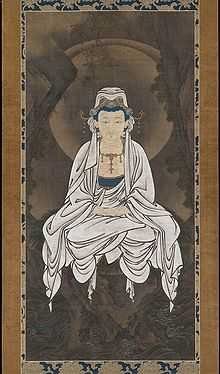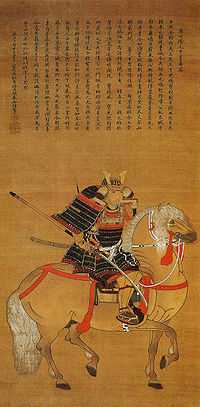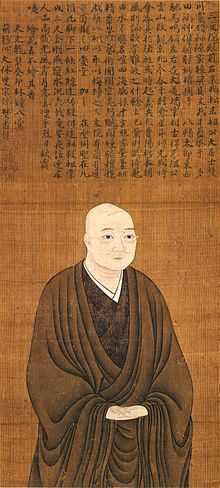Kanō Motonobu

Kanō Motonobu (狩野 元信 August 28, 1476 – November 5, 1559) was a Japanese painter. He was a member of the Kanō school of painting. Through his political connections, patronage, organization, and influence he was able to make the Kano school into what it is today. The system was responsible for the training of a great majority of painters throughout the Edo period (1615–1868).
Family heritage
The Kano family are presumed to be the descendants from a line of warriors from the Kano district. The Kano district is now called Shizuoka Prefecture. The forebear of this family was Kanō Kagenobu. He seems to have been a retainer of the Imagawa family. It has been reported that he painted a picture of Mount Fuji for a visit to the shogun Ashikaga Yoshinori in 1432. The Kano family dominated the painting world from the end of the Muromachi period (1333–1568) to the end of the Edo period (1600–1868).
Kanō Masanobu, Motonobu’s father, was the founder of the Kanō school. Kano Masanobu was the official court painter to the Ashikaga shogunate in 1481. Masanobu was a professional artist whose style derived from Kanga style. Masanobu’s descendants were the people that made up the Kano school. The Kano school had secular ink painters.

Early years
Motonobu was likely trained in Kanga (Chinese-style ink painting) by his father and probably acquired his skill as a portrait painter. One example of this would be the priest Tōrin, 1521; Kyoto, Ryōan-ji. Motonobu was given many commissions for paintings from a variety of sources. His sources included; the Ashikaga government, members of the aristocracy, and major Kyoto shrines and temples. From these commissions Motonobu was able to develop his painting skills further. Motonobu, like his father, commissioned for the Ashikaga shoguns.
Motonobu was only nine when he began to serve the shogun Ashikaga Yoshimasa and then his successors: Ashikaga Yoshitane, Yoshizumi and Yoshiharu. One member of the elite was Hosokawa Takakuni who commissioned Motonobu to paint a set of narrative handscrolls in 1513. They are entitled Kurama-dera engi (‘Origins of Kurama temple’; untraced).
Works
Motonobu's clients were from the imperial court and merchant classes mainly in Kyoto and Sakai. One of his earliest documented contracts was for a set of votive plaques (e-ma). These plaques depicted the Thirty-six Poetry Immortals. It was ordered by a group of Sakai merchants in 1515 for the Shinto shrine of Itsukushima in what is now Hiroshima Prefecture. The Sanjōnishi family liked Motonobu’s work and in 1536 they invited him to give a painting performance. This family was well associated with the imperial court. The performance was done on a two-panel folding screen and performed in front of a group of guests. Motonobu presented the folding screens to Emperor Go-Nara. Motonobu had to be flexible to serve each of the patron’s individualistic taste. Motonobu is considered as the patriarch of the Kano School. Motonobu played an important role because he combined his artistic talent with versatility.
A lot of his paintings are still preserved in temples at Kyoto. His paintings are on the panels of Reiun-in monastery in Kyoto. Motonobu did the principle rooms in the monastery. Motonobu's paintings that were on the sliding panels are now mounted on hanging scrolls. These hanging scrolls include 49 Landscapes with Flowers and Birds.

Kanō school
Tosa Mitsunobu, the founder of the Tosa school of painting, was Motonobu’s father-in-law. The Tosa school specialized in the Yamato-e (a Japanese painting style). Mitsunobu combining the strong brushwork of suiboku-ga with the decorative appeal of the Yamato-e. This style was suitable for large compositions and it dominated Japanese painting for the next three hundred years.
Motonobu was head of the small Kanō workshop in the 1530s. The workshop was located in northern Kyoto. The Kanō school only had about ten painters. The workshop consisted of Motonobu’s three sons, Shōei (1519–1592), Yusetsu (1514–1562), and Joshin. Also in the workshop was Motonobu’s younger brother Yukinobu (1513–1575) and some assistants that might have not been blood related. Since Motonobu was the head or chief architect of these paintings he took on the contracting for the projects. He also was responsible for the production and organization of the projects. Motonobu was very involved with the marketing of his work, and also in his studio. He received a broad amount of patronage. He was a very smart businessman. He had a petition present to a shogun. The petition also included the merchant Hasuike Hideaki. The petition applied for a vast amount of production and sales in fans. Motonobu also took on the most salient, detailed parts of the paintings. He devised the compositions in sketches. In large commission he did the most important rooms in a building. Motonobu's son and assistants would then do the other parts of production. They would grind pigments, prepared the paper, painted the background color or simply fill in large areas of color. As the commissions grew so did the amount of assistants. Motonobu provided the organizational and artistic skills necessary. The other parts of the guild are also important because they helped produced the finished product.
Motonobu had a good reputation and he became very famous in Kyoto, as did his workshop. He was held in such high regard by his generation. Some of the commissions he was involved in are prestigious. Motonobu was involved in the decoration of Ishiyama Hongan-ji in Osaka between 1539 and 1553. Ishiyama Hongan-ji is the chief temple of the Jōdo Shinshū (Pure Land) sect of Buddhism. This is unusual because Motonobu was a member of the Nichiren or Hokke sect. This group was arch-enemies of the Jōdo Shinshū. In 1541, Motonobu sent one hundred fans and three folding screens to the Ming emperor as gifts. Like his father, Motonobu received a series of honorary court and religious titles, culminating in that of hōgen (Eye of the Law), which he was using by 1546.
Motonobu trained his workshop which was full of members of his family and other apprentices to execute his many designs. His designs were items like folding fans to the prominent screen-and-wall paintings of the time. The workshop trained other artists by watching the master painter work. The students would watch Motonobu work and would gain experience by helping with commissions. Motonobu gave students the tools necessary for them to succeed. He unified the production of the hereditary members with the other associates in the workshop. One tool was that he standardized his compositions, and only had minor stylistic changes in them. The students would practice Motonobu’s style daily.
Style
Motonobu also had a style of brushwork that he is very famous for. Motonobu's painting have minimal color in them. The forms are organic, natural, and full of drama. These paintings are also known as suiboku-ga (sumi-e) monochromatic water-ink paintings. The brushwork is very dramatic and expressive.
Motonobu was good at producing landscapes. He introduced heavily stressed outlines and bold decorative patterns. These landscapes were produced in both monochrome and in lighter colors. Motonobu was very skillful at creating a variety of figures, flowers and bird pictures.
The screen paintings that Motonobu made served as architectural decorations. They appealed greatly to the warrior class. Some of his landscape paintings where executed utilizing three different styles. The styles are by three different masters. The soft ink-wash style was made by Mu-ch'i Fa-ch'ang. The more rigid, hard, stiff style is produced by Hsia Kuei. Lastly, the broken ink style was made by Yü Chien (c. 1230).
Motonobu had some paintings in the Yamato-e style. The set of hand scrolls Seiryō-ji no engi (‘Origins of Seiryō-ji’, 1515; Kyoto, Seiryō-ji). These hand scrolls show that he has a mastery of this style and its conventions. Motonobu was a master of many of the major pictorial styles of his time.
He not only did paintings but he applied three different styles of calligraphy. The first, is a formal style known as shintai (new form). The second and more informal form was known as gyōsho (running style). The third form is a cursive style called sōsho (grass, very cursive style).
Legacy
One of Motonobu's greatest achievements was in the creation of a new technique for painting. This technique formed the basis for early Kano school style. The technique was known as wa-kan, a mixture of Japanese and Chinese painting. This combination had the spatial solidity and careful brushwork techniques of Kanga. It also had some of the characteristics of Yamato-e style for instance the fine line, decorative patterning. It also had further associations with Yamato-e like the use of colors and gold leaf. The wall panels depicting Birds and Flowers of the Four Seasons shows this combination of style. One of these hanging scrolls dates back to c. 1513 (Kyoto, Daitoku-ji, Daisen-in). The other hanging scroll dates back to 1543–1549 (Kyoto, Myōshin-ji, Reiun-in).
He taught other generations everything he learned. This established some creativity and flexibility in the Kano school. The Story of Xiang yan (Tokyo, N. Mus.) shows the emergence of Kano style, although, it has an underlying Chinese philosophy to it. But the figure in the foreground is active and the vertical plane makes the painting Japanese. The brushwork and compositional elements also make the painting appear distinctively Japanese.
The Kano school flourished because of leaders like Motonobu. His reputation, talent and developed organizational skills made this possible. The school was founded in the fifteenth century but has had a long-lasting impact. The system was patriarchal and modeled after other guilds before its time. Strict teaching made the Kano school a success. Teaching was a focus in the school and Motonobu stressed this idea. He let others watch him so he cared about future generations developing his unique style.
References
- Kenkyusha's New Japanese-English Dictionary, Kenkyusha Limited, Tokyo 1991, ISBN 4-7674-2015-6.
- Mason, R.H.P. and J.G.Caiger, A History of Japan, Tokyo 1977, ISBN 02210003494615
- Art Grove Dictionary. Oxford University Press 2007-2009.
- Jordan, Brenda G. and Victoria Weston. Copying the Master and Stealing His Secrets: Talent and Training in Japanese Painting. University of Hawai’i Press; Honolulu, 2003.
- Encyclopædia Britannica Online.
External links
- Bridge of dreams: the Mary Griggs Burke collection of Japanese art, a catalog from The Metropolitan Museum of Art Libraries (fully available online as PDF), which contains material on this artist (see index)
| Wikimedia Commons has media related to Kano Motonobu. |
|